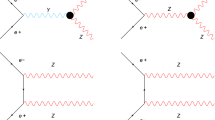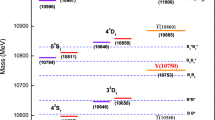Abstract
We consider the subleading contributions of the hadronic vacuum polarization, involving the π0γ*γ* transition form factor, to the muon anomalous magnetic moment g − 2. Various models for the form factor, based on hadronic ansatzes and holographic principles, are considered: They are the Wess-Zumino-Witten, vector meson dominance, lowest meson dominance (one and two vector resonances), and anti-de Sitter/quantum chromodynamics (AdS/QCD) models. The model parameters are determined by fitting the experimental data for the e+e−→ π0γ total cross section. We report the following numerical result for the corrections to the muon g − 2: the resulting values of two vector resonances model are one order-of-magntitude smaller than the one obtained from the dispersion relation.
Similar content being viewed by others
References
F. Jegerlehner and A. Nyffeler, Phys. Rept. 477, 1 (2009). doi:10.1016/j.physrep.2009.04.003 [arXiv:0902. 3360 [hep-ph]].
C. Patrignani et al. [Particle Data Group], Chin. Phys. C 40, 100001 (2016). doi:10.1088/1674-1137/40/10/100001
F. Jegerlehner, arXiv:1705.00263 [hep-ph].
D. W. Hertzog, EPJ Web Conf. 118, 01015 (2016). doi:10.1051/epjconf/201611801015 [arXiv:1512.00928 [hep-ex]].
T. Aoyama, M. Hayakawa, T. Kinoshita and M. Nio, Phys. Rev. Lett. 109, 111808 (2012). doi:10.1103/Phys RevLett.109.111808 [arXiv:1205.5370 [hep-ph]].
C. Gnendiger, D. Stckinger and H. Stckinger-Kim, Phys. Rev. D 88, 053005 (2013). doi:10.1103/PhysRev D.88.053005 [arXiv:1306.5546 [hep-ph]].
M. Della Morte,_B. Jager, A. Juttner and H. Wittig, JHEP 1203, 055 (2012). doi:10.1007/JHEP03(2012)055 [arXiv:1112.2894 [hep-lat]].
P. Boyle, L. Del Debbio, E. Kerrane and J. Zanotti, Phys. Rev. D 85, 074504 (2012). doi:10.1103/PhysRevD.85.074504 [arXiv:1107.1497 [hep-lat]].
F. Burger et al. [ETM Collaboration], JHEP 1402, 099 (2014). doi:10.1007/JHEP02(2014)099 [arXiv:1308.4327 [hep-lat]].
T. Blum, S. Chowdhury, M. Hayakawa and T. Izubuchi, Phys. Rev. Lett. 114, 012001 (2015). doi:10.1103/PhysRevLett.114.012001 [arXiv:1407.2923 [hep-lat]].
T. Blum, N. Christ, M. Hayakawa, T. Izubuchi, L. Jin and C. Lehner, Phys. Rev. D 93, 014503 (2016). doi:10.1103/PhysRevD.93.014503 [arXiv:1510.07100 [hep-lat]].
B. Chakraborty, C. T. H. Davies, P. G. de Oliviera, J. Koponen, G. P. Lepage and R. S. Van de Water, Phys. Rev. D 96, 034516 (2017). doi:10.1103/PhysRevD.96.034516 [arXiv:1601.03071 [hep-lat]].
S. Borsanyi et al. [Budapest-Marseille-Wuppertal Collaboration], arXiv:1711.04980 [hep-lat].
M. Knecht and A. Nyffeler, Phys. Rev. D 65, 073034 (2002). doi:10.1103/PhysRevD.65.073034 [hepph/ 0111058].
A. Nyffeler, Phys. Rev. D 94, 053006 (2016). doi:10.1103/PhysRevD.94.053006 [arXiv:1602.03398 [hep-ph]].
D. K. Hong and D. Kim, Phys. Lett. B 680, 480 (2009). doi:10.1016/j.physletb.2009.09.026 [arXiv:0904.4042 [hep-ph]].
D. K. Hong, D. Kim and S. Matsuzaki, Phys. Rev. D 81, 073005 (2010). doi:10.1103/PhysRevD.81.073005” [arXiv:0911.0560 [hep-ph]].
L. Cappiello, O. Cata and G. D’Ambrosio, Phys. Rev. D 83, 093006 (2011). doi:10.1103/PhysRevD.83.093006 [arXiv:1009.1161 [hep-ph]].
M. Davier, A. Hoecker, B. Malaescu and Z. Zhang, arXiv:1706.09436 [hep-ph].
T. Blum, Phys. Rev. Lett 91, 052001 (2003). doi:10.1103/PhysRevLett.91.052001 [hep-lat/0212018].
E. de Rafael, Phys. Lett. B 322, 239 (1994). doi:10.1016/0370-2693(94)91114-2 [hep-ph/9311316].
S. L. Adler, Phys. Rev. 177, 2426 (1969). doi:10.1103/PhysRev.177.2426.
J. S. Bell and R. Jackiw, Nuovo Cim. A 60, 47 (1969). doi:10.1007/BF02823296.
G. P. Lepage and S. J. Brodsky, Phys. Lett. B 87, 359 (1979). doi:10.1016/0370-2693(79)90554-9.
G. P. Lepage and S. J. Brodsky, Phys. Rev. D 22, 2157 (1980). doi:10.1103/PhysRevD.22.2157.
S. J. Brodsky and G. P. Lepage, Phys. Rev. D 24, 1808 (1981). doi:10.1103/PhysRevD.24.1808.
V. A. Novikov, M. A. Shifma, A. I. Vainshtein, M. B. Voloshin and V. I. Zakharov, Nucl. Phys. B 237, 525 (1984). doi:10.1016/0550-3213(84)90006-3.
B. Moussallam, Phys. Rev. D 51, 4939 (1995). doi:10.1103/PhysRevD.51.4939 [hep-ph/9407402].
M. Knecht, S. Peris, M. Perrottet and E. de Rafael, Phys. Rev. Lett. 83, 5230 (1999). doi:10.1103/PhysRevLett.83.5230 [hep-ph/9908283].
M. Knecht and A. Nyffeler, Eur. Phys. J. C 21, 659 (2001). doi:10.1007/s100520100755 [hep-ph/0106034].
K. Melnikov and A. Vainshtein, Phys. Rev. D 70, 113006 (2004). doi:10.1103/PhysRevD.70.113006, [hepph/ 0312226].
A. Grardin, H. B. Meyer and A. Nyffeler, Phys. Rev. D 94, 074507 (2016). doi:10.1103/PhysRevD.94.074507 [arXiv:1607.08174 [hep-lat]].
H. R. Grigoryan and A. V. Radyushkin, Phys. Rev. D 77, 115024 (2008). doi:10.1103/PhysRevD.77.115024 [arXiv:0803.1143 [hep-ph]].
H. R. Grigoryan and A. V. Radyushkin, Phys. Lett. B 650, 421 (2007). doi:10.1016/j.physletb.2007.05.044 [hep-ph/079].
S. Hong, S. Yoon and M. J. Strassler, JHEP 04, 003 (2006). doi:10.1088/1126-6708/2006/04/003 [hepth/ 0409118].
M. N. Achasov et al. Phys. Rev. D 93, 092001 (2016). doi:10.1103/PhysRevD.93.092001 [arXiv:1601.08061 [hep-ex]].
V. B. Berestetskii, O. N. Krokhin and A. K. Khelbnikov, JETP 3, 761 (1965).
Author information
Authors and Affiliations
Corresponding author
Rights and permissions
About this article
Cite this article
Hong, D.K., Kim, D.H. & Lee, JW. Subleading hadronic vacuum polarization contributions to muon g − 2: μ+μ− → γ* → π0γ*. Journal of the Korean Physical Society 72, 221–227 (2018). https://doi.org/10.3938/jkps.72.221
Received:
Accepted:
Published:
Issue Date:
DOI: https://doi.org/10.3938/jkps.72.221




